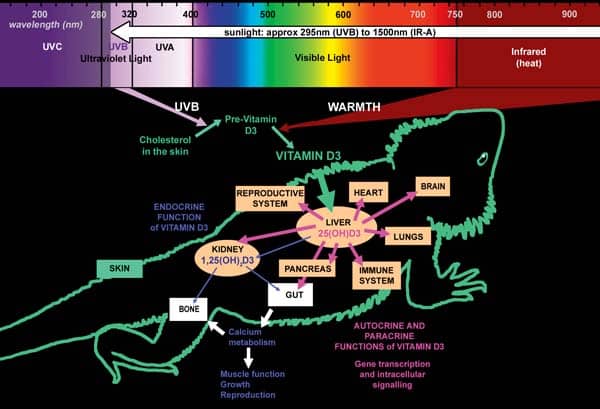UV or Not UV? That is the Question
My first article for REPTILES magazine (“Catching Wavelengths,” May 2009) began with these words: To a reptile, sunlight is life … Careful provision of lighting is essential for a healthy reptile in captivity. Over the last seven years, there has been an explosion of interest in providing appropriate full-spectrum lighting, including ultraviolet (UV), to all species. A huge number of new products have been launched to meet the growing demand. But do all reptiles benefit from UV? And if so, how much UV should be offered, and what lamp will be suitable? In this article I hope to share with you some of the exciting developments I’ve seen over the last seven years regarding UV and its use with reptiles.
What is Ultraviolet?
Ultraviolet is simply a normal part of the light from the sun. Physicists subdivide it by wavelength, into a long wavelength fraction, UVA (320-400 nm), and a short-wavelength fraction, UVB (290-320 nm). In outer space, sunlight also contains even shorter wavelengths, but fortunately for life on Earth, our atmosphere filters out this harmful radiation. Every part of the sunlight that the atmosphere does let through, however, is utilized by life on Earth, including, of course, reptiles and amphibians.
“Ultraviolet” gets its name because its wavelengths have only slightly greater energy than the wavelengths we see as violet light. Reptiles can see UVA, invisible to us. Just as we do, reptiles recognize other animals and food items by their colors and markings, many of which include UVA-color. This is why lighting containing UVA is an essential part of herp husbandry.

Frances M. Baines
Fig. 1. We can’t imagine what it’s like to lose UVA from the spectrum, but if we take out another color, in this case red, we can understand the effect it has (right). How can we tell the berries are ripe?
Ordinary incandescent lamps and halogen basking lamps emit small amounts of UVA. All “UVB reptile lamps” emit plenty of UVA; metal halide bulbs are particularly good sources, which together with their extremely high output of visible light makes them excellent simulators of sunlight. Lamps that do not emit UVA, such as white and colored LEDs and red heat lamps, don’t allow full color vision to reptiles and should not be a main source of light in the vivarium.
Powerful UVB
UVB is invisible to reptiles, but its high-energy short wavelengths are biologically active. The UV in sunlight is an effective disinfectant that can destroy bacteria, fungi and viruses on the surface of the skin. UV also has direct effects upon skin, which include strengthening of skin barrier functions, increasing pigment formation and modulating the skin’s immune responses. It also stimulates production of beta endorphins, giving sunlight its “feel good” factor, and induces nitric oxide production, which has localized protective effects on skin cells.
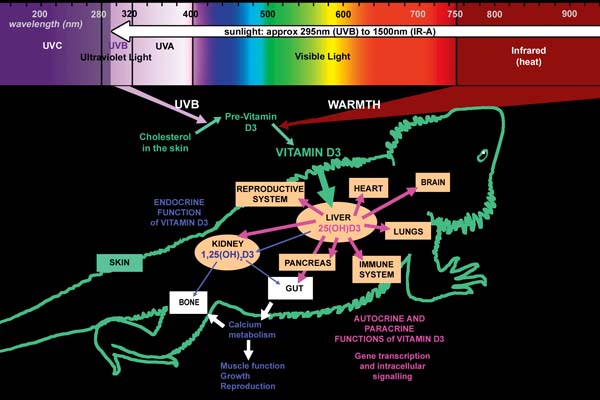
FRANCES M. BAINES
The vitamin D3 pathway.
Perhaps the most well-known and vital effect of UVB, however, is its ability to convert a natural cholesterol in the skin to pre-vitamin D3. Warmth, typically also absorbed while basking, converts the pre-vitamin D3 to vitamin D3. Vitamin D3 is used for vital functions throughout the body (see Figure 1). It is taken up from the skin into the bloodstream, then carried to the liver, where it is converted into a storage form called 25(OH)D3. This then re-enters the bloodstream and is carried throughout the body. A blood test for 25(OH)D3 is the best way of measuring an animal’s vitamin D3 status.
A small amount of 25(OH)D3 is essential for life. It is processed by the kidneys into the active hormone, 1,25(OH)2D3. (Blue arrows on the diagram). This vital endocrine hormone controls the levels of calcium in the bloodstream. Adequate circulating calcium is absolutely essential for muscles and nerves to function, and is also vital for normal growth and reproduction. 1,25(OH)D3 enables the gut to absorb calcium from the diet, and maintains stores of calcium laid down in bone. If a reptile develops metabolic bone disorder (MBD) as a result of vitamin D3 deficiency, this means that levels were desperately low, not even sufficient to make the tiny amounts of active hormone so necessary for life.
However, when supplies of vitamin D3 are plentiful, the liver can produce much more 25(OH)D3 than is needed by the kidneys. (Pink arrows on the diagram). Other organs can take up 25(OH)D3 and turn it into the active form inside their cells. There, it controls as many as 2,000 genes influencing a huge range of functions, including cell division and the immune system. Adequate vitamin D3 is needed for full health, not just the bare minimum that keeps MBD at bay.
Where Do Wild Reptiles Get Vitamin D3?
All wild vertebrates maintain some level of vitamin D3 in their bodies, so carnivorous reptiles can, if necessary, obtain all their vitamin D3 from consuming their prey. However, insectivorous and herbivorous reptiles cannot do this, as invertebrates and plants do not synthesize vitamin D3. Many species can absorb vitamin D3 when it is given as a supplement with food, but this is hardly a natural process! It seems likely that the natural way these reptiles obtain their vitamin D3 is from synthesis in their skin when it is exposed to UVB during daylight hours.
Over the last few years, the ability of UVB to enable vitamin D3 synthesis has been demonstrated in diurnal reptiles from a wide range of taxa. We now have scientific evidence for this process in carnivores (black-throated monitors [Varanus albigularis ionidesi] and Komodo dragons [V. komodoensis], insectivores (panther chameleons [Furcifer pardalis], veiled chameleons [Chamaeleo calyptratus], day geckos [Phelsuma madagascariensis], Texas spiny lizards [Sceloporus olivaceus] and tropical anoles [Anolis sagrei and A. lineotopus]), herbivores (chuckwallas [Sauromalus ater], green iguanas [Iguana iguana] and Hermann’s tortoises [Testudo hermanni]) and omnivores (bearded dragons [Pogona vitticeps] and red-eared sliders [Trachemys scripta elegans]). All these species have evolved bodily characteristics and behaviors that optimize their UV exposure for vitamin D3 synthesis and the other beneficial effects of sunlight. Typically, thermoregulatory behavior simultaneously minimizes the risk of overheating and UV damage. In arid deserts, for example, sun-loving species bask mainly early and late in the day, avoiding excessive radiation. Many also have tough, sun-resistant skin.
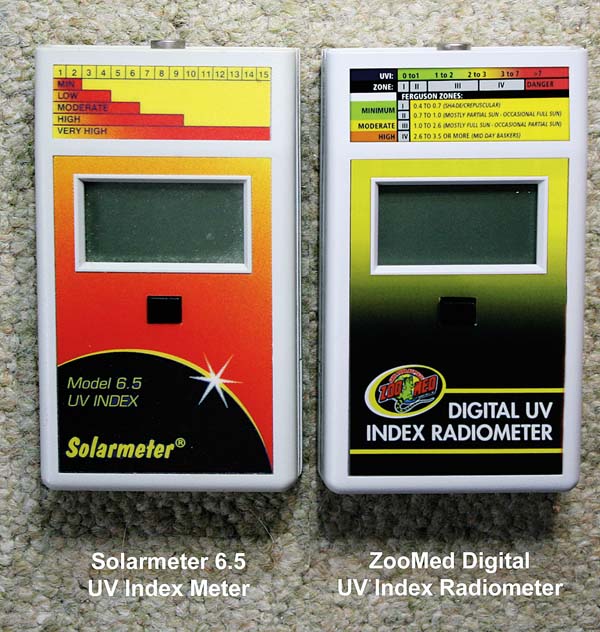
Frances M. Baines
Fig. 4. Two UV index meters proven reliable for both sunlight and lamp measurement. Inexpensive “sun smart” meters gave false results with lamps owing to their wider spectral sensitivity.
What About Nocturnal Reptiles?
It is often said that crepuscular and nocturnal species are never out in sunlight, and so they do not benefit from UV. However, so-called “nocturnal” species often do make daytime forays and some, such as the Moorish gecko (Tarentola mauritanica), can be frequently observed basking in full sunlight in the wild. Many species traditionally classified as nocturnal may in fact be cathemeral (irregularly active at any time of night or day, according to prevailing circumstances). Reptile keepers often report seeing daytime basking behavior in so-called “nocturnal” reptiles when they are provided with full-spectrum lighting.
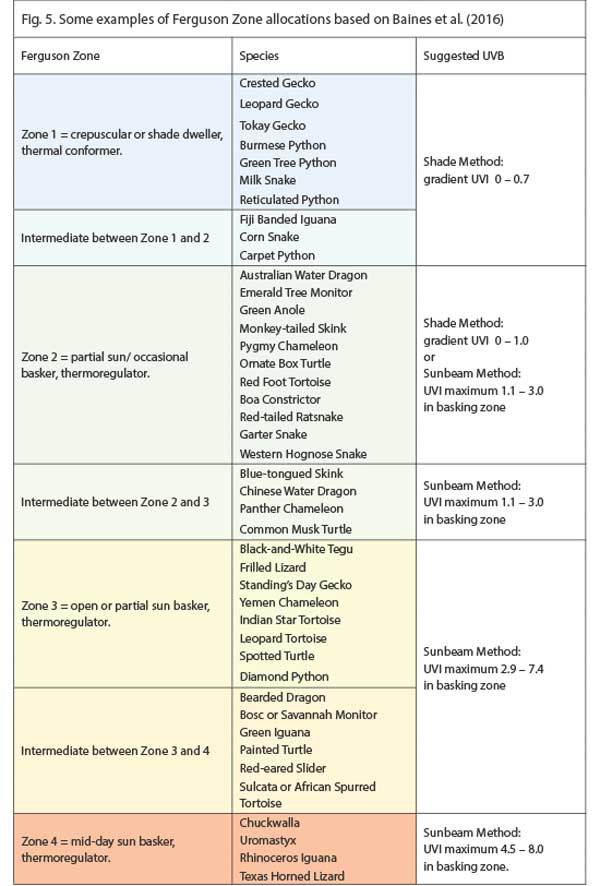
FFRANCES M. BAINES
Some examples of Ferguson Zone allocations based on Baines et al. (2016).
In the wild, even those that are rarely active when the sun is above the horizon may spend the day resting in places where daylight, which includes UV, filters through. Many arboreal snakes and geckos hide in tree foliage or behind crevices in bark during the day. Leaf-tailed geckos (Uroplatus spp.), for example, sleep in daylight against tree trunks in Madagascar. Terrestrial reptiles may sleep in the partial shelter of undergrowth or leaf litter, or in burrows with parts of the body, often the tail, close to the entrance. Levels of UVB in these deeply shaded places may be very low, but the animals are receiving it for many hours each day. Some species also appear to have very low vitamin D3 requirements.
Few studies have yet been done on vitamin D3 synthesis in nocturnal and crepuscular reptiles, but it has been proven for the leopard gecko (Eublepharis macularius), house gecko (Hemidactylus frenatus) and corn snake (Pantherophis guttatus). Some nocturnal snakes and geckos have skin which is more transparent to UV than the more protective skin of diurnal species, and produces vitamin D3 more efficiently. They can thus make use of low levels of UVB.
Creating a Microhabitat
If reptiles have evolved to make best use of the sunlight they experience in their native microhabitat, then to provide them with optimal conditions in captivity, we need to replicate the lighting found in this microhabitat as closely as possible. This certainly does not mean looking up UV records from tropical weather stations, which have instruments mounted on exposed rooftops. Nor does it mean attempting to calculate a daily UVB “dose” and trying to irradiate our animals with it.
Instead, we need to ensure that our vivariums allow their inhabitants the freedom to self-regulate their exposure to heat, light and UV within the range that is appropriate for the species. In the wild, sunlight interacts with features such as trees, rocks, plants and water, creating superimposed gradients of heat, light and UV extending from full sunlight into full shade. Providing similar gradients in the vivarium is the key to success, and because the heat, light and UV received from a lamp is proportional to its distance from the subject, it is possible to select a product, or combination of products, to create almost any desired effect.
How Much UVB Does My Reptile Need?
Ideally, we should be relying upon individual studies made in the wild for every species we keep. Until very recently, no practical methods even existed for measuring UV in the microhabitat of wild reptiles. However, in 2010, a team of herpetologists from Texas Christian University, led by Professor Gary Ferguson, published recordings of daily UV exposure of 15 species of reptiles tracked in the wild, using the UV Index (UVI), measured with a Solarmeter 6.5 UV Index meter. This meter is especially useful, as it measures UV irradiance in the wavelengths that enable vitamin D3 synthesis.
The team noticed that the 15 species could easily be allocated into one of four microhabitats or “zones” (which have since been called the Ferguson Zones) according to their daily sun exposure. The team also suggested that zone allocation could be extended much further. Knowledge of the basking/daylight exposure habits of any species might enable a reasonable estimation of likely UV exposures to be made.
The four Zones may be summarized in this way:
Zone 1 = crepuscular or shade dweller, thermal conformer/
Average exposure: UVI 0-0.7; maximum recorded: UVI 0.6-1.4
Zone 2 = partial sun/occasional basker, thermoregulator
Average exposure: UVI 0.7-1.0; maximum recorded: UVI 1.1-3.0
Zone 3 = open or partial sun basker, thermoregulator
Average exposure: UVI 1.0-2.6; maximum recorded: UVI 2.9-7.4
Zone 4 = mid-day sun basker, thermoregulator
Average exposure: UVI 2.6-3.5; maximum recorded: UVI 4.5-9.5
The average (of all the UVI readings for the microhabitats at the time and place the reptiles were found) might be seen as a suitable “mid-background” level of UVB for the species in each zone. The maximum figures might reflect “one-off” exposures — a single reptile found out in mid-day sun — but they give a rough idea of the maximum levels this type of animal might encounter naturally. This suggests an upper acceptable limit for the UVB gradient to be provided in captivity. A gradient is vital; there must be a full range of UV levels from zero (full shade) to the maximum suggested by the Zone assessment (at the closest point possible between the reptile and the lamp).
In 2012, the British and Irish Association of Zoos and Aquaria (BIAZA) compiled a document allocating Ferguson Zones to 254 species of reptiles and amphibians and suggesting suitable UV lighting options for animals kept in zoos and similar institutions. Contributors to this included private herpetologists, specialist reptile keepers and 14 zoological organizations. In January 2016, it was published in the free access online Journal of Zoo and Aquarium Research. Figure 5 gives some examples of the Ferguson Zones suggested for a range of commonly kept reptiles.
Two Ways to Supply UVB to Captive Reptiles
The Shade Method provides low-level background UV over a large proportion of the animal’s enclosure, using the “average exposure” figures as a guide, with a gradient to zero into shade. This would normally be the method of choice for shade-dwelling reptiles and those that rarely bask (i.e., those in Zones 1 and 2).
These iso-irradiance charts are scale drawings of the UV Index gradients for seven lamps shown 12 inches above the eye level of a 6-inch tortoise — not to indicate suitable positioning for any tortoise, but to emphasize the size and shape of the beam.
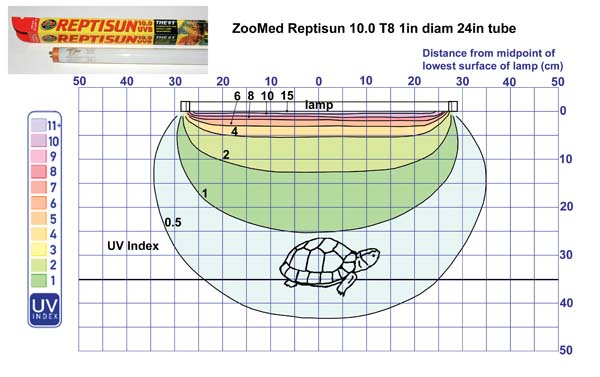
FRANCES M. BAINES
ZooMed Reptisun 10.0 T8 1in diam 24in tube.
The Sunbeam Method is designed to provide a higher level of UV for species known to bask in direct sunlight. This higher level must be restricted to the basking zone (“like a sunbeam”) with a gradient to zero into shade. This method would seem appropriate for reptiles in Zones 3 and 4, and for some reptiles in Zone 2 when a distinct basking zone is to be provided.
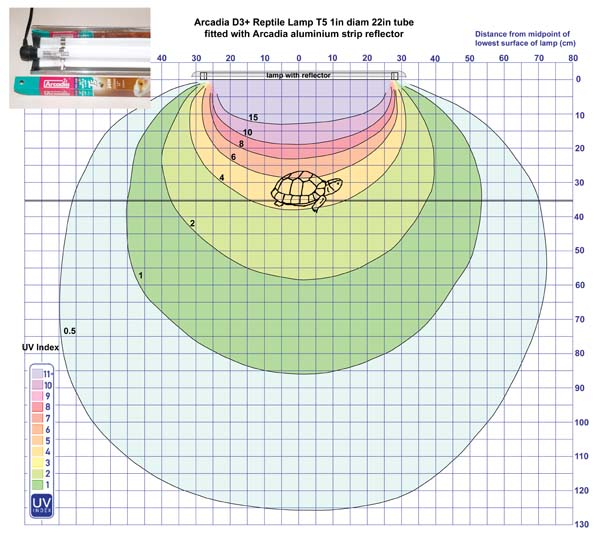
FRANCES M. BAINES
Arcadia D3+ Reptile Lamp T5 1in diam 22in tube fitted with Arcadia aluminium strip reflector.
The aim is to provide UV similar to that which the animal would experience when in direct sunlight during a typical early to mid-morning basking period, when most species bask. At that time, UV levels are rising but still moderate, typically around UVI 3.0-5.0. Many reptiles have been observed basking at far higher levels at other times of the day. However, because the UV spectrum from artificial lighting is not the same as from natural sunlight, it’s suggested that for safety, when the “sunbeam method” is employed, UVI 3.0 should be considered the absolute maximum UVI at reptile level for Zone 2 reptiles, and UVI 7.0-8.0 as absolute maximum for Zone 3 and 4 reptiles.
What About Albinos?
Albino and hypomelanistic morphs of any species are likely to be more sensitive to UV and visible light, and will need much-reduced exposure levels. Skin pigments, especially melanin, block UV radiation. A lack of skin and eye pigmentation therefore allows a higher percentage of UV to penetrate the cells, increasing the risks of UV skin damage (“sunburn”) and even cancer. Fortunately, this increased UV transmission means that adequate vitamin D3 synthesis should still be possible despite lower UV exposure.
Choosing the Right UV Lamps for Your Vivarium
Once the UVB requirement of your reptile has been determined, the next step is to choose a suitable lighting set-up. Lighting and heating must always be planned together, and when creating a thermal gradient, the whole of the animal’s body must fit within the optimum upper temperature zone. For basking species, this means creating a basking area in which appropriate UV, visible light and infrared radiation cover the entire body of the animal. Lamps with wide, flood-type beams or multiple lamps above the basking zone are often necessary.
Whether a UVB lamp is suitable for a given species depends upon two things: its spectrum, and its irradiance at the distance required. Ideally, the spectrum should be as close as possible to natural sunlight. Comparisons are outside the scope of this article, but good-quality lamps now available have no hazardous very-short-wavelength UVB or UVC. UVB-emitting fluorescent tubes and metal halide lamps have spectra that are fairly similar to sunlight in the UVB range.
The irradiance from a lamp at any given distance depends upon the output of the lamp and the shape of the beam. These vary enormously, not just between different types of lamps, but also different brands with similar specifications and, sometimes, even between individual lamps of the same brand. The use of various lamp reflectors, domes and luminaires can also dramatically affect the shape of the beam and its intensity. Output also decreases with use, primarily due to solarization of the glass. After an initial settling-in period, typically the first 100 hours of use, however, most products decay only slowly.
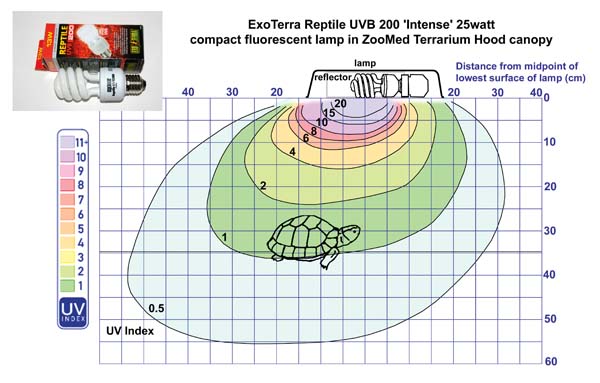
FRANCES M. BAINES
ExoTerra Reptile UVB 200 “Intense” 25watt compact fluorescent lamp in ZooMed Terrarium Hood canopy.
UV gradients can be mapped using the UV Index meter. Examples of widely differing results from a range of popular products are shown in Figure 6 (more are available at uvguide.co.uk). Ideally, keepers should use a UV Index meter to determine positioning of a lamp and to monitor its decay, but if no meter is available, charts like these can act as guides if the exact same lamps are being used. Manufacturer’s guidelines as to minimum safe distances must always be respected. Excessive exposure to UV must be avoided because high doses can result in eye and skin damage.
Lamps for the Shade Method
UVB fluorescent tubes (regular T8, 1-inch diameter) produce diffuse, low levels of UVB over a relatively large area close to the tube. This resembles outdoor shade on a sunny day, very suitable for the Shade Method in small vivariums, where the maximum UVI required would be no higher than UVI 0.7-1.0. Brands vary widely in UVB output, which can be doubled when a reflector is used. They produce little heat, low levels of visible light and should always be combined with a higher-quality visible light source. Good-quality tubes should only need replacing yearly.
In larger vivariums, high-output T5 (T5-HO) tubes (slim 16mm diameter) may be used, positioned further from the animals, to obtain the same low UVI at animal level.
UVB compact fluorescent lamps also produce diffuse, low levels of UVB at basking distances, but the UVB is limited to a small area, and at close range the light and UVB may be intense, making good positioning difficult. They can be very useful in canopies over the mesh tops of small terrariums, creating UV zones for smaller arboreal species. These decay more rapidly than tubes and may need replacement after 6 months’ use.
Lamps to Create Sunbeams
Mercury vapor and metal halide UVB lamps are “high intensity discharge” (HID) lamps that can produce much higher levels of UVB, typical of natural sunlight. These are suitable for the Sunbeam Method, adding UV to a brightly illuminated basking zone so that whenever the reptile chooses to bask, it receives safe but effective levels of UVB. However, HID lamps cannot be used with either an on/off thermostat (because frequent switching will cause an unacceptable strobe effect for the reptiles, and also premature failure of the lamp or ballast) or a dimmer (because as soon as the voltage drops, the arc fails and the lamp goes out), so it’s important to select a wattage that will not overheat the basking zone at the correct distance for the UVB.
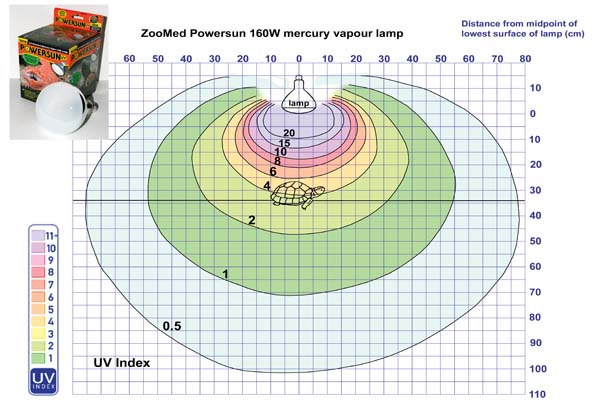
frances m. baines
ZooMed Powersun 160W mercury vapour lamp.
Mercury vapor UVB lamps are very popular, but they vary widely in quality and UVB output, and the visible light, although bright, does not have optimal spectral quality. “Flood” lamps with coated glass faces can create a wide zone of bright light, UVB and heat directly below the lamp. Less expensive “spot” lamps with clear glass faces may produce extremely narrow, hazardous beams of very intense UV light and heat, and should be avoided.
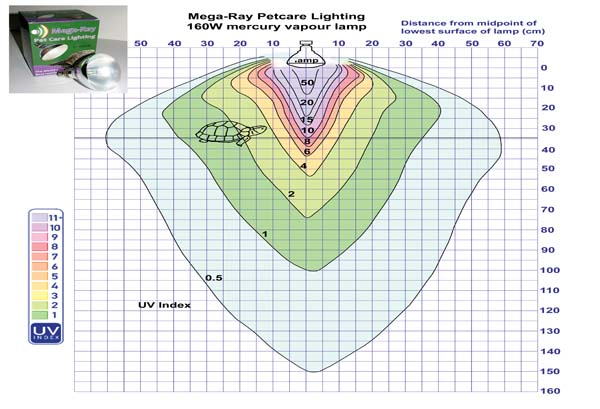
frances m. baines
Mega-Ray Petcare Lighting 160W mercury vapour lamp.
Metal halide UVB lamps, popular in Europe for some time, are now available in the U.S. They produce extremely bright light with a very broad spectrum including UVB, UVA, visible light and infrared, making them the best sunlight simulators. They do, however, require external ballasts and lampholders that can cope with a high-voltage ignition pulse. These items are usually sold as kits (one manufacturer has the ballast neatly incorporated into the lampholder itself).
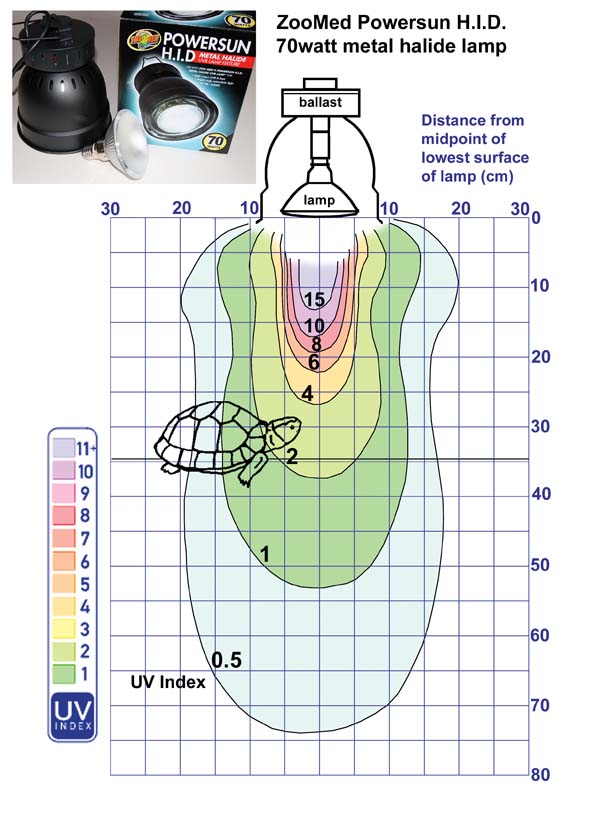
FRANCES M. BAINES
ZooMed Powersun H.I.D.70 watt metal halide lamp.
Positioning metal halide UVB lamps appropriately is crucial, because at close range the visible light is extremely intense, and the lamp must never be looked into directly. The only disadvantages with current models seem to be that their beams are quite narrow, and the UVB, but not the visible light, decays rather faster than tubes.
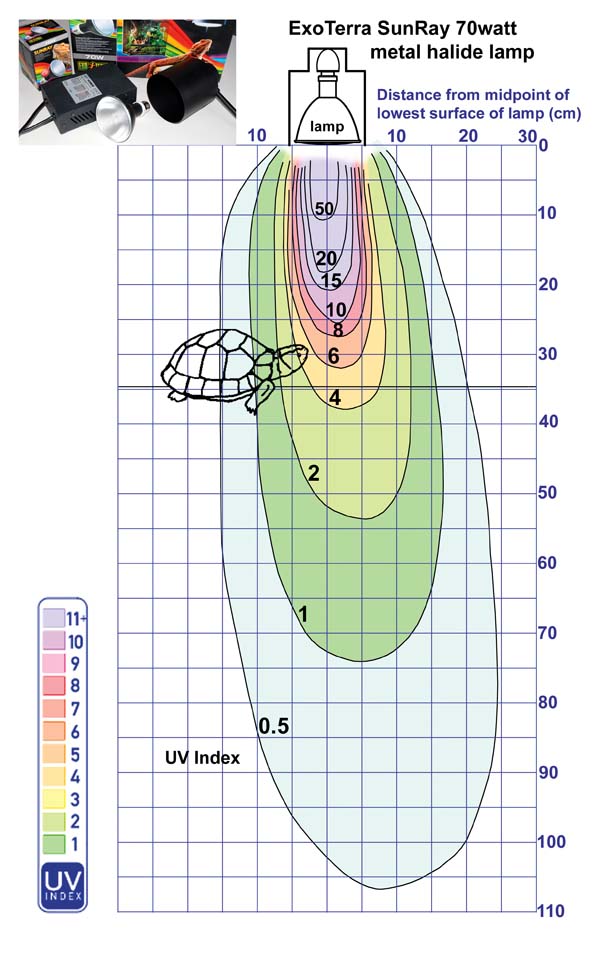
FRANCES M. BAINES
ExoTerra Sun Ray 70 watt metal halide lamp.
High-output T5 (T5-HO) tubes are unsurpassed in their ability to create extremely large, strong UVB zones, especially when used in reflector fixtures. They also produce fairly bright visible light, but little heat, so must be combined with non-UVB-emitting incandescent lamps to create a large basking zone. High-quality brands have excellent longevity, with a high proportion of tubes maintaining UVB output for well over a year.
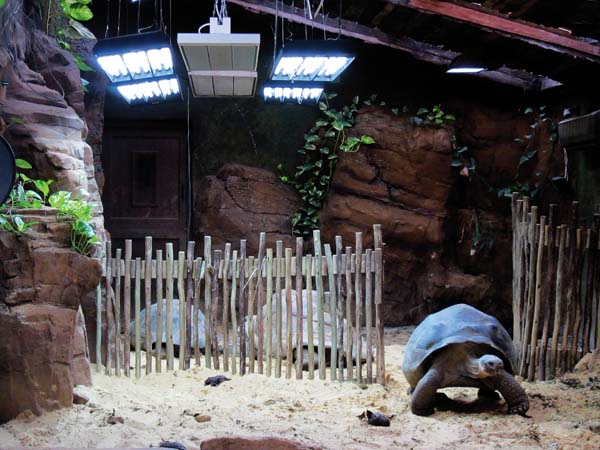
Indoor accommodations for Galapagos tortoises at ZSL London Zoo. Four Arcadia SuperZoo TF-HO fixtures, each holding six 4-foot Arcadia TF D3+ 12% UVB Reptile Lamp fluorescent tubes, and two ceramic heater panels create a basking zone that is 14-feet wide.
The effect of overlapping beams is additive, so zoos have been able to create enormous UVB zones for giant reptiles by using multiple T5-HO lamps in horticultural reflector fixtures, hung high above the animals (Figure 7).
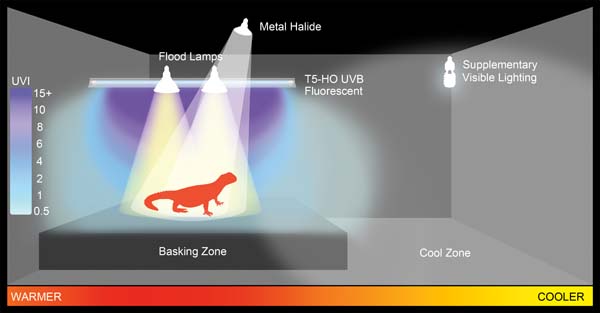
M. versweyveld
Fig. 8. Diagram of a basking zone created for a reptile in Ferguson Zone 3 or 4, using a combination of a T5-HO UVB fluorescent tube for UVB, with incandescent basking lamps and a non-UVB metal halide lamp for visible light and heat.
Creating a really well-lit vivarium is not possible using just one lamp. However, a combination of lamps, bulbs and tubes, used with care and sensitivity, can go a long way toward bringing “sunlight” indoors, and meeting the needs of all reptiles in captivity.
Dr. Frances BAINES, MA, VetMB, MRCVS, has spent the last 12 years researching the use of specialist lighting, including ultraviolet lighting, in the husbandry of reptiles, amphibians and, more recently, mammals, birds and invertebrates. She is an appointed Advisor to the British and Irish Association of Zoos and Aquaria (BIAZA) Reptile & Amphibian Working Group and to the European Association of Zoos and Aquaria (EAZA) Animal Welfare Working Group. She lives in Wales, UK, with “a little horde of lizards and my long-suffering husband.”

